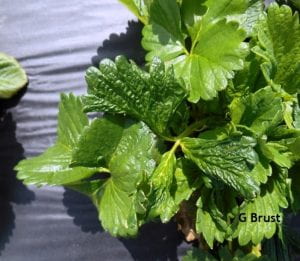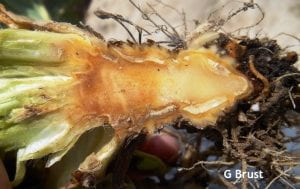Jerry Brust, IPM Vegetable Specialist, University of Maryland; jbrust@umd.edu
I have seen several strawberry fields in the past week that have some plants with distorted wrinkled appearing foliage (Fig. 1). These leaves almost look like they have a virus, but the new foliar growth looks normal. This damage is most likely due to cold injury we had sometime this frigid spring and does not pose much of a problem as far as yield or fruit quality. However, another cold injury to the strawberry plants was seen in these same strawberry fields. This damage can be best seen in small plants that do not seem to be growing as well as many of their neighbors. When these plants are dug out of the bed the roots still look good (i.e., white and firm), but if the crown of the plant is cut length wise then the problem is apparent (Fig. 2). The strawberry crown is actually a shortened plant stem. The central part of the crown, called the pith, is made up of large cells which are easily injured and turn brown because of the formation of ice crystals during winter or early spring. This central pith tissue is normally white and is sensitive to frost damage. Generally, minor freezing injury is characterized by a partial browning of the pith. However, with greater injury, the pith takes on a deeper shade of brown and the surrounding vascular layer turns brown or even black (Fig. 2). Any injury to the vascular layer will represent loss of later plant growth, since the food and water conducting elements located in this layer have been damaged. After you make the longitudinal cut you should make your assessment of the tissue quickly because in about 30 seconds, the entire pith area will become darker in appearance because of exposure to air—not necessarily because of tissue damage.
Strawberry plants are quite resilient and even if there is internal cold injury to crown tissues plants can still recover, but the process could be slow and there will probably be some yield loss. This browning of the pith tissue also could be due to anthracnose, a plant disease. Anthracnose often causes a wilting of the plant and a reddish-brown area of the crown (Fig. 3). All the strawberry plants I saw with a brown pith were checked for anthracnose, which was not found. Growers should be sure to determine whether the brown tissue is due to cold injury or a disease.
Figure 1. The distorted wrinkled leaves are showing signs of cold damage. The older and younger leaves around them are normal looking.
Figure 2. The crown was cut length wise. The brown central pith tissue (arrows) has been damaged due to cold injury.
Figure 3. Anthracnose in the crown of a strawberry plant.




